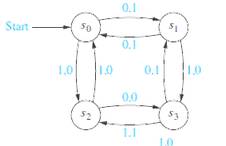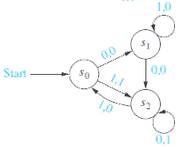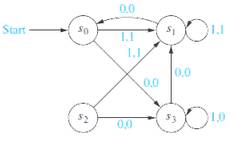
Discrete Mathematics and Its Applications ( 8th International Edition ) ISBN:9781260091991
8th Edition
ISBN: 9781259676512
Author: Kenneth H Rosen
Publisher: McGraw-Hill Education
expand_more
expand_more
format_list_bulleted
Concept explainers
Textbook Question
Chapter 13.2, Problem 2E
Give the state tables for the finite-state machine with these state diagrams.
a) 
b
c
Expert Solution & Answer
Want to see the full answer?
Check out a sample textbook solution
Students have asked these similar questions
Find the sample space.
Sunscreen
SPF
10, 15, 30, 45, 50
Type
Lotion, Spray, Gel
The graphs of the function F (left, in blue) and G (right, in red) are below. Answer the following questions.
F'(1)
G'(1)
F'(6)
G'(6)
1. One of the partial fractions for
2
4x²+x-9
x3+2x²-3x
2
x+1
a) x23 b) x 1½ c) x² d)
x-1
x
is
Chapter 13 Solutions
Discrete Mathematics and Its Applications ( 8th International Edition ) ISBN:9781260091991
Ch. 13.1 - Exercises 1-3 refer to the grammar with start...Ch. 13.1 - Exercises 1-3 refer to the grammar with start...Ch. 13.1 - Prob. 3ECh. 13.1 - Let G=(V,T,S,P) be the phrase-structure grammar...Ch. 13.1 - Prob. 5ECh. 13.1 - Prob. 6ECh. 13.1 - Prob. 7ECh. 13.1 - Show that the grammar given in Example 5 generates...Ch. 13.1 - Prob. 9ECh. 13.1 - Prob. 10E
Ch. 13.1 - Construct a derivation of 021222 in the grammar...Ch. 13.1 - Show that the grammar given in Example 7 generates...Ch. 13.1 - s13. Find a phrase-structure grammar for each of...Ch. 13.1 - Find a phrase-structure grammar for each of these...Ch. 13.1 - Find a phrase-structure grammar for each of these...Ch. 13.1 - Construct phrase-structure grammars to generate...Ch. 13.1 - Construct phrase-structure grammars to generate...Ch. 13.1 - Construct phrase-structure grammars to generate...Ch. 13.1 - Prob. 19ECh. 13.1 - A palindrome is a string that reads the same...Ch. 13.1 - Let G1 and G2 be context-free grammars, generating...Ch. 13.1 - Prob. 22ECh. 13.1 - Construct derivation trees for the sentences in...Ch. 13.1 - Let G be the grammar with V={a,b,c,S};T={a,b,c} ;...Ch. 13.1 - Prob. 25ECh. 13.1 - Prob. 26ECh. 13.1 - Prob. 27ECh. 13.1 - a) Explain what the productions are in a grammar...Ch. 13.1 - Prob. 29ECh. 13.1 - a) Construct a phrasestructure grammar for the set...Ch. 13.1 - Give production rules in Backus-Naur form for an...Ch. 13.1 - Prob. 32ECh. 13.1 - Prob. 33ECh. 13.1 - Prob. 34ECh. 13.1 - Prob. 35ECh. 13.1 - Prob. 36ECh. 13.1 - Prob. 37ECh. 13.1 - Prob. 38ECh. 13.1 - Prob. 39ECh. 13.1 - Prob. 40ECh. 13.1 - Prob. 41ECh. 13.1 - Let G be a grammar and let R be the relation...Ch. 13.2 - Draw the state diagrams for the finite-state...Ch. 13.2 - Give the state tables for the finite-state machine...Ch. 13.2 - Find the output generated from the input string...Ch. 13.2 - Find the output generated from the input string...Ch. 13.2 - Find the output for each of these input strings...Ch. 13.2 - Find the output for each of these input strings...Ch. 13.2 - Construct a finite-state machine that models an...Ch. 13.2 - Prob. 8ECh. 13.2 - Construct a finite-state machine that delays an...Ch. 13.2 - Construct a finite-state machine that changes...Ch. 13.2 - Construct a finite-state machine for the log-on...Ch. 13.2 - Construct a finite-state machine for lock that...Ch. 13.2 - Construct a finite-state machine for a toll...Ch. 13.2 - Construct a finite-state machine for entering a...Ch. 13.2 - Construct a finite-state machine for a restricted...Ch. 13.2 - Construct a finite-state machine that gives an...Ch. 13.2 - Prob. 17ECh. 13.2 - Construct a finite-state machine that determines...Ch. 13.2 - Construct a finite-state machine that determines...Ch. 13.2 - Prob. 20ECh. 13.2 - Prob. 21ECh. 13.2 - Find the output string generated by the Moore...Ch. 13.2 - Prob. 23ECh. 13.2 - Construct a Moore machine that gives an output of...Ch. 13.2 - Prob. 25ECh. 13.3 - Prob. 1ECh. 13.3 - 2. Show that if A is a set of strings, then.
Ch. 13.3 - Find all pairs of sets of strings A and B for...Ch. 13.3 - Show that these equalities hold. a) {}*={} b)...Ch. 13.3 - Prob. 5ECh. 13.3 - Prob. 6ECh. 13.3 - Prob. 7ECh. 13.3 - Prob. 8ECh. 13.3 - Prob. 9ECh. 13.3 - Determine whether the string 01001 is in each of...Ch. 13.3 - Determine whether each of these strings is...Ch. 13.3 - Determine whether each of these strings is...Ch. 13.3 - Determine whether all the strings in each of these...Ch. 13.3 - Show that if M=(S,I,f,so,F) is a deterministic...Ch. 13.3 - Given a finite-state automaton M=(S,I,f,so,F) ,...Ch. 13.3 - In Exercises 16—22 find the language recognized by...Ch. 13.3 - In Exercises 16—22 find the language recognized by...Ch. 13.3 - Prob. 18ECh. 13.3 - Prob. 19ECh. 13.3 - In Exercises 16—22 find the language recognized by...Ch. 13.3 - In Exercises 16—22 find the language recognized by...Ch. 13.3 - Prob. 22ECh. 13.3 - Construct a deterministic finite-state automaton...Ch. 13.3 - Construct a deterministic finite-state automaton...Ch. 13.3 - Construct a deterministic finite-state automaton...Ch. 13.3 - Construct a deterministic finite-state automaton...Ch. 13.3 - Prob. 27ECh. 13.3 - Construct a deterministic finite-state automaton...Ch. 13.3 - Prob. 29ECh. 13.3 - Construct a deterministic finite-state automaton...Ch. 13.3 - Construct a deterministic finite-state automaton...Ch. 13.3 - Construct a deterministic finite-state automaton...Ch. 13.3 - Prob. 33ECh. 13.3 - Prob. 34ECh. 13.3 - Prob. 35ECh. 13.3 - Prob. 36ECh. 13.3 - Prob. 37ECh. 13.3 - Prob. 38ECh. 13.3 - Prob. 39ECh. 13.3 - Use Exercise 39 finite-state automata constructed...Ch. 13.3 - Prob. 41ECh. 13.3 - Prob. 42ECh. 13.3 - Prob. 43ECh. 13.3 - Prob. 44ECh. 13.3 - Prob. 45ECh. 13.3 - In Exercises 43-49 find the language recognized by...Ch. 13.3 - Prob. 47ECh. 13.3 - In Exercises 43-49 find the language recognized by...Ch. 13.3 - Prob. 49ECh. 13.3 - Find a deterministic finite-state automaton that...Ch. 13.3 - Prob. 51ECh. 13.3 - Find a deterministic finite-state automaton that...Ch. 13.3 - Find a deterministic finite-state automaton that...Ch. 13.3 - Find a deterministic finite-state automaton that...Ch. 13.3 - Find a deterministic finite-state automaton that...Ch. 13.3 - Find a nondeterministic finite-state automaton...Ch. 13.3 - Prob. 57ECh. 13.3 - Prob. 58ECh. 13.3 - Prob. 59ECh. 13.3 - Prob. 60ECh. 13.3 - Prob. 61ECh. 13.3 - Prob. 62ECh. 13.4 - Describe in words the strings in each of these...Ch. 13.4 - Prob. 2ECh. 13.4 - Prob. 3ECh. 13.4 - Prob. 4ECh. 13.4 - Express each of these sets using a regular...Ch. 13.4 - Express each of these sets using a regular...Ch. 13.4 - Express each of these sets using a regular...Ch. 13.4 - Construct deterministic finite-state automata that...Ch. 13.4 - Construct nondeterministic finite-state automata...Ch. 13.4 - Construct nondeterministic finite-state automata...Ch. 13.4 - Show that if A is a regular set, then AR, the set...Ch. 13.4 - Using the construction described in the proof of...Ch. 13.4 - Using the construction described in the proof of...Ch. 13.4 - Construct a nondeterministic finite-state...Ch. 13.4 - In Exercises 15-17 conflict a regular grammar...Ch. 13.4 - In Exercises 15-17 conflict a regular grammar...Ch. 13.4 - In Exercises 15-17 conflict a regular grammar...Ch. 13.4 - Show that the finite-state automaton constructed...Ch. 13.4 - Show that the regular grammar constructed from a...Ch. 13.4 - Show that every nondeterministic finite-state...Ch. 13.4 - Let M=(S,I,f,s0,F) be a deterministic finite-state...Ch. 13.4 - One important technique used to prove that certain...Ch. 13.4 - Show that the set 02n1nn=0,1,2,... is not regular...Ch. 13.4 - Show that the set {1n2n=0,1,2,...} is not regular...Ch. 13.4 - Show that the set of palindromes over {0, 1} is...Ch. 13.4 - Prob. 26ECh. 13.4 - Prob. 27ECh. 13.4 - Prob. 28ECh. 13.4 - Prob. 29ECh. 13.4 - Prob. 30ECh. 13.4 - Use Exercise 29 to show that the language...Ch. 13.5 - Let T be the Turing machine defined by the...Ch. 13.5 - Let T be the Turing machine defined by the...Ch. 13.5 - What does the Turing machine defined by the...Ch. 13.5 - What does the Turing machine described by the...Ch. 13.5 - What does the Turing machine described by the...Ch. 13.5 - Construct a Turing machine with tape 0, 1, and B...Ch. 13.5 - Construct a Turning machine with tape symbols 0,...Ch. 13.5 - Construct a Turing machine with tape symbols 0, 1,...Ch. 13.5 - Construct a Turing machine with tape symbols 0, 1,...Ch. 13.5 - Construct a Turing machine with tape symbols 0, 1,...Ch. 13.5 - Construct a Turing machine that recognizes the set...Ch. 13.5 - Construct a Turing machine that recognizes the set...Ch. 13.5 - Construct a Turing machine that recognizes the set...Ch. 13.5 - Show at each step the contents of the tape of the...Ch. 13.5 - Explain why the Turing machine in Example 3...Ch. 13.5 - Construct a Turing machine that recognizes the set...Ch. 13.5 - Construct a Turing machine that recognizes the set...Ch. 13.5 - Construct a Turing machine that computes the...Ch. 13.5 - Construct a Turing machine that computes the...Ch. 13.5 - Construct a Turing machine that computes the...Ch. 13.5 - Construct a Turing machine that computes the...Ch. 13.5 - Construct a Turing machine that computes the...Ch. 13.5 - Construct a Turing machine that computes the...Ch. 13.5 - Construct a Turing machine that computes the...Ch. 13.5 - Construct a Turing machine that computes the...Ch. 13.5 - Construct a Turning machine that computes the...Ch. 13.5 - Prob. 27ECh. 13.5 - Prob. 28ECh. 13.5 - Which of the following problems is a decision...Ch. 13.5 - Which of the following problems is a decision...Ch. 13.5 - Prob. 31ECh. 13.5 - Show that the function B(n) cannot be computed by...Ch. 13 - a) Define a phrase-structure grammar. b) What does...Ch. 13 - a) What is the language generated by a...Ch. 13 - Prob. 3RQCh. 13 - Prob. 4RQCh. 13 - Prob. 5RQCh. 13 - a) What is a finite-state machine? b) Show how a...Ch. 13 - Prob. 7RQCh. 13 - Prob. 8RQCh. 13 - Prob. 9RQCh. 13 - Prob. 10RQCh. 13 - a) Define a nondeterministic finite-state...Ch. 13 - a) Define the set of regular expressions over a...Ch. 13 - Prob. 13RQCh. 13 - Prob. 14RQCh. 13 - Prob. 15RQCh. 13 - Prob. 16RQCh. 13 - Describe how Turing machines are used to recognize...Ch. 13 - Prob. 18RQCh. 13 - Prob. 19RQCh. 13 - Prob. 1SECh. 13 - Prob. 2SECh. 13 - Prob. 3SECh. 13 - Prob. 4SECh. 13 - Prob. 5SECh. 13 - Prob. 6SECh. 13 - Prob. 7SECh. 13 - Prob. 8SECh. 13 - Prob. 9SECh. 13 - Prob. 10SECh. 13 - Prob. 11SECh. 13 - Prob. 12SECh. 13 - Prob. 13SECh. 13 - Construct a finite-state machine with output that...Ch. 13 - Construct a finite-state machine with output that...Ch. 13 - Prob. 16SECh. 13 - Prob. 17SECh. 13 - Prob. 18SECh. 13 - Construct a deterministic finite-state automaton...Ch. 13 - Prob. 20SECh. 13 - Prob. 21SECh. 13 - Prob. 22SECh. 13 - Prob. 23SECh. 13 - Prob. 24SECh. 13 - Prob. 25SECh. 13 - Show that {02nnN} is not regular. You may use the...Ch. 13 - Prob. 27SECh. 13 - Prob. 28SECh. 13 - Construct a Turing machine that computes the...Ch. 13 - Prob. 30SECh. 13 - Prob. 1CPCh. 13 - Prob. 2CPCh. 13 - Prob. 3CPCh. 13 - Prob. 4CPCh. 13 - Given the state table of a Moore machine and an...Ch. 13 - Given the state table of a Mealy machine and an...Ch. 13 - Given the state table of a deterministic...Ch. 13 - Prob. 8CPCh. 13 - Prob. 9CPCh. 13 - Prob. 10CPCh. 13 - Given a regular grammar, construct a finite-state...Ch. 13 - Given a finite-state automaton, construct a...Ch. 13 - Prob. 13CPCh. 13 - Solve the busy beaver problem for two states by...Ch. 13 - Prob. 2CAECh. 13 - Prob. 3CAECh. 13 - Prob. 4CAECh. 13 - Prob. 5CAECh. 13 - Prob. 1WPCh. 13 - Describe the Backus-Naur form (and extended...Ch. 13 - Explain how finite-state machines are used by...Ch. 13 - Explain how finite-state machines are used in the...Ch. 13 - Explain how finite-state machines are used in...Ch. 13 - Compare the use of Moore machines versus Mealy...Ch. 13 - Explain the concept of minimizing finite-state...Ch. 13 - Give the definition of cellular automata, Explain...Ch. 13 - Define a pushdown automaton. Explain how pushdown...Ch. 13 - Define a linear-bounded automaton. Explain how...Ch. 13 - Prob. 11WPCh. 13 - Prob. 12WPCh. 13 - Prob. 13WPCh. 13 - Show that a Turing machine can simulate any action...Ch. 13 - Prob. 15WPCh. 13 - Describe the basic concepts of the lambda-calculus...Ch. 13 - Show that a Turing machine as defined in this...Ch. 13 - Prob. 18WP
Knowledge Booster
Learn more about
Need a deep-dive on the concept behind this application? Look no further. Learn more about this topic, subject and related others by exploring similar questions and additional content below.Similar questions
- 1. One of the partial fractions for 2 2 4x²+x-9 x3+2x²-3x a) x3 b) x11 c) x² d) z x-1 2. Identify the improper integral. 1 x 2 x dx a) 3x dx b) f² 3x dx 0 3-2x 0 3-2x x is c) √2^: 4 √232x dx d) fo² 3x dx 1 1 0 3-2x B. So eax dx converges to if : a) O if a0 c) - 1½ ifa 0arrow_forwardComplete the square and find the indefinite integral. (Remember to use absolute values where appropriate. Use C for the constant of integration.) dx x²-12x+27arrow_forwardComplete the table. Enter DNE if a quantity doesn't exist or NEI if not enough information is given. f(c) limx-->c- f(x) limx-->c+ f(x) limx -->c f(x) continuity at x=c 2 4arrow_forward
- Find the indefinite integral. (Use C for the constant of integration.) 9x arcsin(x) dxarrow_forwardFind the indefinite integral using the substitution x = 5 sin(e). (Use C for the constant of integration.) 1 dx (25-x²)3/2arrow_forwardFind the indefinite integral using the substitution x = 7 sec(0). (Use C for the constant of integration.) √ ׳ √x² - 49 dxarrow_forward
- Use the Cauchy Riemann equations (polar form version). Also, describe what happens at the branch cut.arrow_forwardb. i. Show that the following matrix is orthogonal. A = ドードー ii Find the inverse of matrix A. Show all working in an organized/orderly manner. 2 3 -619 A = 42 3 1 5 B-1127) a. Given D = , decode the following message: 32, 24, 42, 28, 24, 40, 50, 60, 132, 96, 12, 24arrow_forward2 Graph of h 6. The graph of the function h is given in the xy-plane. Which of the following statements is correct? , the graph of h is increasing at an increasing rate. (A) For (B) For (C) For 苏|4 K|4 π π , the graph of h is increasing at a decreasing rate. 2 0 and b>1 (B) a>0 and 01 (D) a<0 and 0arrow_forwardQUESTION 4 Peter says that the following expressions can be simplified into one trigonometric ratio without the use of a calculator. Prove that Peter is correct by simplifying the following expressions into one trigonometric ratio: 4.1 sin 43° + sin 17º (5)arrow_forward3. Consider the sequences of functions fn: [-T, π] → R, sin(n²x) n(2) n (i) Find a function f : [-T, π] R such that fnf pointwise as n∞. Further, show that f uniformly on [-T,π] as n→ ∞. [20 Marks] (ii) Does the sequence of derivatives f(x) has a pointwise limit on [-7,π]? Justify your answer. [10 Marks]arrow_forwardAmong a student group 54% use Google Chrome, 20% Internet Explorer, 10% Firefox, 5% Mozilla, and the rest use Safari. What is the probability that you need to pick 7 students to find 2 students using Google Chrome? Report answer to 3 decimals.arrow_forwardarrow_back_iosSEE MORE QUESTIONSarrow_forward_ios
Recommended textbooks for you
 Linear Algebra: A Modern IntroductionAlgebraISBN:9781285463247Author:David PoolePublisher:Cengage Learning
Linear Algebra: A Modern IntroductionAlgebraISBN:9781285463247Author:David PoolePublisher:Cengage Learning Elements Of Modern AlgebraAlgebraISBN:9781285463230Author:Gilbert, Linda, JimmiePublisher:Cengage Learning,
Elements Of Modern AlgebraAlgebraISBN:9781285463230Author:Gilbert, Linda, JimmiePublisher:Cengage Learning,

Linear Algebra: A Modern Introduction
Algebra
ISBN:9781285463247
Author:David Poole
Publisher:Cengage Learning

Elements Of Modern Algebra
Algebra
ISBN:9781285463230
Author:Gilbert, Linda, Jimmie
Publisher:Cengage Learning,
How to find the magnitude and direction of a given vector; Author: Brian McLogan;https://www.youtube.com/watch?v=4qE-ZrR_NxI;License: Standard YouTube License, CC-BY
Linear Algebra for Computer Scientists. 2. Magnitude of a Vector; Author: Computer Science;https://www.youtube.com/watch?v=ElnuSJyUdR4;License: Standard YouTube License, CC-BY